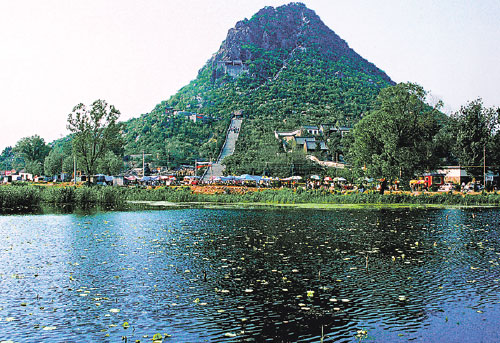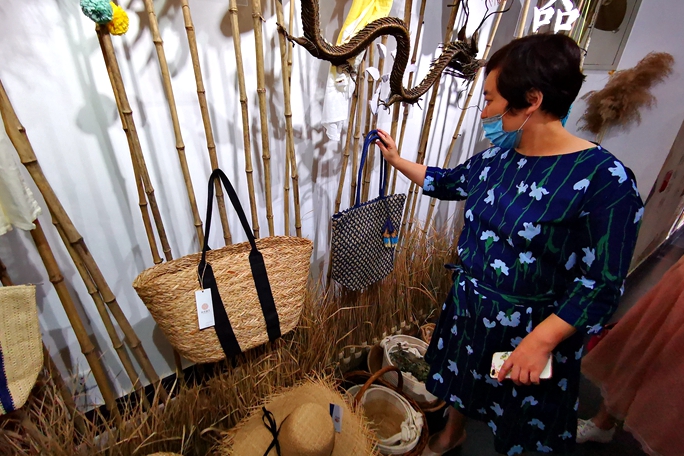Huabuzhu Hill - a stunning local attraction unknown to tourists
Huabuzhu Hill in the northeastern suburb of Jinan, in Shandong province, may not be a well-known scenic spot for tourists, but it is an inalienable part of local life.
"Although I grew up at the foot of the hill, I had not climbed it until the 1990s. It is a mysterious place," says Wang Qinghua, the writer of a book on Jinan's most famous hill: Huabuzhu.
The 192-meter tall circular-cone-shaped hill stands alone on a vast plain to the south of the Yellow River, and appears higher than its actual elevation.
|
Huabuzhu Hill is located in the northeastern suburb of Jinan, Shandong province. It may not be a well-known scenic spot for tourists, but it is an inalienable part of local life. Provided to China Daily |
For most of the time, from the 1940s to early 1990s, the isolated peak was used by the army - it had anti-aircraft guns on top and barbed wire along its perimeter at the bottom.
It is said that the hill, which is covered with huge earth-colored stones, had also been hollowed out to be used as an ammunition depot.
Wang recalled that his first visit to the hill in 1998 was like treasure-hunt, a view shared by many of the residents of the 17 villages who lived in the vicinity of the hill.
Describing his first visit, Huang Jianhua, a local villager, says: "We found dozens of broken stone tablets along a wild dirt path.
"The pieces were inscribed either with ancient Chinese characters or delicate patterns."
Now, many residents climb the mountain - half an hour to the top via neat stone steps.
At the top one can see the stone foundation of a temple.
There is also a large well-preserved Taoist temple dating back to the Song Dynasty (AD 960-1279) at the foot of the mountain, besides a small Taoist temple about halfway up.
The large temple is called Huayang and consists of 17 halls and several courtyards.
There are also dozens of cypress trees, which are about 800 years, in the area.
The temple halls contain exquisite frescoes which are covered under a thick layer of plaster.
It is believed that this was done to protect them during the political movements of the 1960s and the 1970s.
Besides Taoist gods, statues of Mi Ziqian and Pang Choufu are also found in the temple.
The two lived about 2,000 years ago near the hill, and are worshipped, respectively, for their filial piety and unswerving loyalty to the king.
Speaking of the two figures, Li Xiaoyong, a local resident in his late 80s, says: "For us, Mi and Pang represent the hills' cultural values. They have been role models for local children for generations."
Despite the military occupation putting the hill out of bounds for the locals for a long period, it did result in the hill and Huayang being protected from environmental damage.
Almost proving this point, two small hills nearby have nearly disappeared due to rampant quarrying.
In the year 2000, Huabuzhu was made a park, and then upgraded to a provincial-level geological park.
Meanwhile, research has uncovered that a host of famous poets and artists over the centuries were inspired by the fabulous views of Huabuzhu, when it was surrounded by water, and that there are many classic artworks celebrating this view still in existence.
Huabuzhu, means a lotus bud in the water, and the name probably refers to a time when water surrounded the hill.
But the lake gradually receded to a few ponds as a canal in late Song Dynasty was dug to connect Jinan to Bohai Bay.
The ponds' water comes from a natural spring called Huaquan at the foot of the hill's southern slope.
There are legends about almost every large stone on the hill. And Wang spent nearly 10 years studying the legends and history of the hill before writing the book on it.
"I am just proud of this hill, though I have not known it for very long," he says.
liyang@chinadaily.com.cn
(China Daily 09/15/2016 page10)


 Shandong Culture and Tourism Consumption Season
Shandong Culture and Tourism Consumption Season Culture, tourism sectors pick up in Shandong as epidemic wanes
Culture, tourism sectors pick up in Shandong as epidemic wanes

